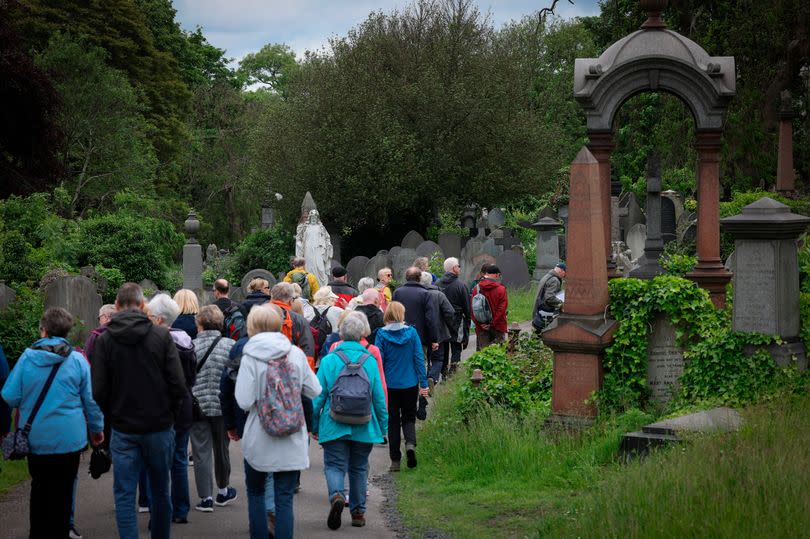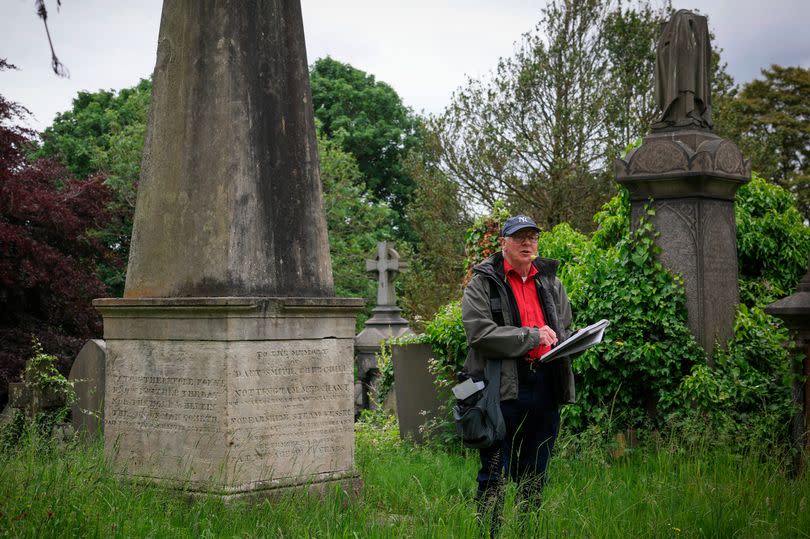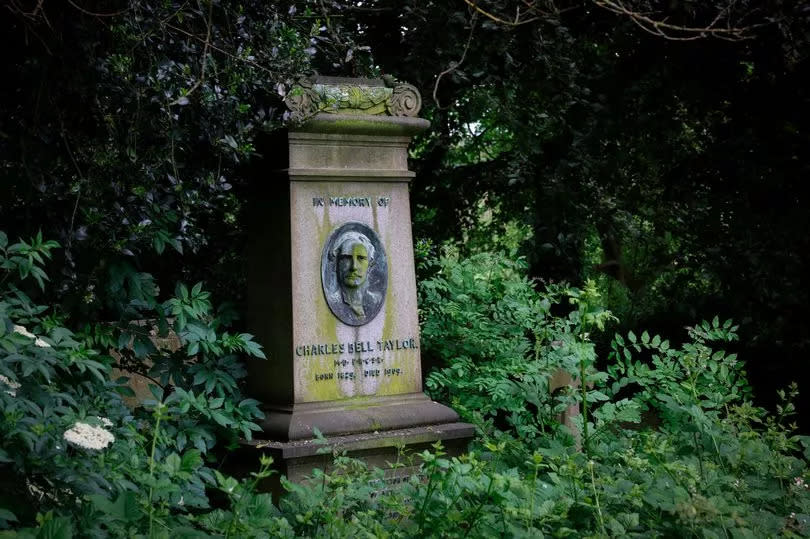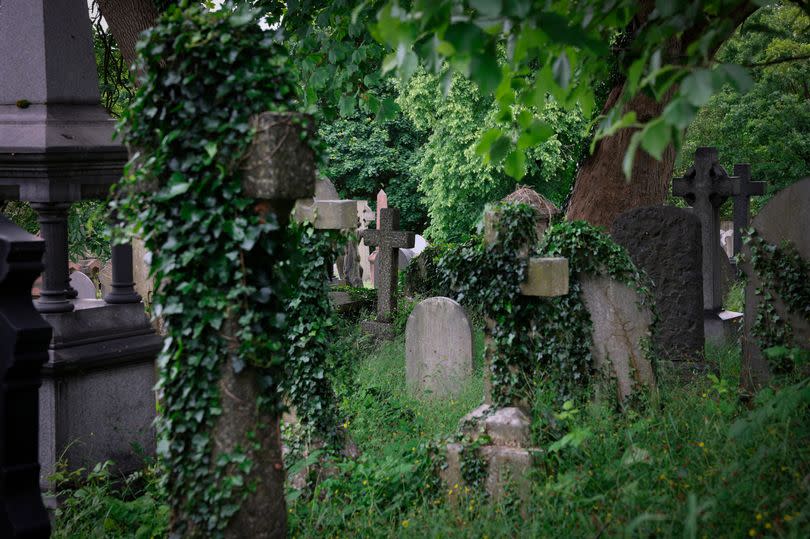I went on a Nottingham cemetery tour and it was fascinating

Nottingham has all kinds of tours... there's a ghost walk, a trail following the finest buildings of architect Watson Fothergill, and of, course, the story of Robin Hood. One of the more unusual walks is around a cemetery. Call me morbid but I find it fascinating looking around an old graveyard - only by day, mind.
Here I am, while other people are shopping, working, or sat watching daytime TV, trudging around the General Cemetery on a guided tour - and I have to say with more than two-and-a-half hours of stories, both educational and entertaining, it's well worth the three quid.
The cemetery is behind the almshouses in Alfreton Road, Canning Circus. It was created after the city's church graveyards could take no more.
Get the latest What's On news straight to your phone by joining us on WhatsApp
The Nottingham General Cemetery Company was set up by an Act of Parliament in 1836. The company purchased 12 acres of land for £5,885. It grew and grew, stretching as far as the Arboretum.
All was going well until it was reported that the bodies were not being buried deep enough and were too close together, breaking Home Office guidelines, says our guide Kevin Powell, of Nottingham Civic Society. It led to the cemetery closure in 1923 - and from then on the only burials were those in existing family plots. Fewer bodies meant less money so the General Cemetery Company went bankrupt, with the cemetery passing to the Crown.

Despite protestations, the Crown off-loaded it to Nottingham City Council for the princely sum of one shilling (five pence) in 1956 and has remained in the local authority's ownership ever since.
Many of Nottingham's great and good, from the mid-1800s to early 1900s, are buried there - leading lace manufacturers, doctors and war heroes amongst them. One of the grandest monuments is dedicated to Richard Birkin and his family. The wrought-iron fencing surrounding it has broken away.
The famous Nottingham lace manufacturer died at his home, Aspley Hall in 1870. "Richard Birkin is a story of rags to riches," says Kevin. "He taught himself. He had a basic schooling, the son of a calico loom weaver, at the age of seven he went into the same mill as his father and worked 12-hour days until he was 17 years old.
"He moved Basford working in lace industry. He became so successful that he started to purchase lace design and then started to create his own and bought machinery to produce them. By 1840 he had his own own company of 30 machines and employed 200 men, women and children. He bought the patent for applying what was called the jacquard patterning system for creating ultra patterns in lace.
"By 1853 they'd outgrown the business and moved to new premises off Stoney Street. Thomas Chambers Hine built him a new factory, creating what was called Broadway."
After retiring at the age of 51, he went into local politics, becoming a councillor and Nottingham's Lord Mayor on four separate occasions. "This is not a grave, this is a vault. It's probably the size of the front room in modern houses," says Kevin.
The fact it's a vault was only discovered when cast iron tubes were found in the four corners, a sign of ventilation. The monument is engraved with a star, which some people mistakenly take for the Star of David. Kevin says: "People always ask was he Jewish? The answer is no. There are no Jewish people in this cemetery. This marks the fact he was a Freemason."
A man by the name of Daft Smith Churchill has an obelisk, a tapering monument like a tall pyramid, as opposed to a headstone. A hosiery manufacturer and trustee of the General Cemetery Company, he met his end in tragic circumstances. He died in the wreckage of a steam boat off the Northumberland coast in a heavy storm on the night of September 7 1838, aged 48. The boat struck rocks and broke in half. Some passengers were cast into the sea, others were clinging onto the wreckage.
Grace Darling, 22, saw the incident from a lighthouse window, and joined her father in a rowing boat in a bid to rescue the passengers. Kevin says: "In Victorian clothes they set sail on a big rowing boat and rowed a mile out to the ship and managed to rescue nine people.
"They got back to the lighthouse, unloaded, and her father and two of the men went back out again. The boat broke up and sank and there was a great loss of life but 42 were saved out of the 62 passengers on the boat. Sadly Daft Smith Churchill was one of those who died. The monument was erected by directors of GCC in gratitude to him but it's getting a bit worn and the top is missing."
Parts of the cemetery are overgrown and neglected, meaning our 30-strong group has to trample over thorny brambles, weeds and long grass. The grave of cigarette manufacturer John Player is somewhere beneath the undergrowth, and can't be found much to the annoyance of Kevin.
Player was born in Essex in 1839 and moved to Nottingham, where he set up a shop selling seeds in Beastmarket Hill. He also sold loose tobacco which actually became more profitable than seeds. He went on to purchase Wright's, a tobacco company in 1877 in Broadmarsh, then moved to Radford and started Players, which eventually merged with Imperial Tobacco.
"He was the first person to make ready rolled cigarettes and the first to incorporate cigarette cards into the packets," says Kevin. He died in 1884 and is buried beneath a black granite slab, now hidden by weeds.
Although stained the gravestone of Charles Bell Taylor is more visible. Born in 1829, he became an eye surgeon who pioneered cataract operations. He worked hard, often seeing 100 patients a day, and would perform up to 20 operations. A keen animal lover he was also against experiments on animals.

He died aged 79 in 1909, putting his long life down to abstaining from alcohol, tobacco, tea and coffee. It is one of the few monuments with a bronze plaque.
Ivy removed from adjacent flats has been left covering some of the graves we're supposed to see. One belongs to Elizabeth Wood, who died in childbirth in January 1846 aged 38. The grave is inscribed with an emotional message that Kevin reads from his notes.
He says: "It's one of the most beautiful verses in this cemetery: Reader behold and drop a tear, beauty's remain lie buried here, nature profuse of beauty store, here gave till she could give no more, but heaven which lent its transient boon hath bid her sun go down at noon. With charms meridian half enjoyed in sorrow she brought forth and died. I always like to bring people here because I find it quite moving."
One of the graves belongs to William Frederick Wallett, who was known as the Queen's Jester. Laughter must have been good for him as he lived to the ripe old age of 85, dying in 1892. In 1833, the circus and theatre entertainer appeared with a troupe before Queen Victoria at Windsor Castle.
The monarch, famed for saying 'I am not amused', laughed so Wallett grabbed the opportunity to call himself the Queen's Jester. It appeared on all his publicity material and even his mother would go around saying her son was the Queen's Jester. The inscription on is headstone reads: "To have known him was in itself a liberal education."
Optician Philip Myers would have made a huge difference to people's lives in the 1800s - not only in terms of their eyesight but their personal hygiene. In an era when most homes didn't have baths or hot running water, he opened a bath house in Pelham Street in 1834.
Described as helping the "amelioration of health" and "one of the luxuries of the town" there was a swimming bath, a hot bath, shower bath, vapour bath and eau de cologne bath. Two nights of the week were for women only.
It's not just the rich and successful who are remembered here. An eccentric character from Nottingham's past, Benjamin Mayo, has a plaque in his name although he is actually buried in Barker Street cemetery. He died in Nottingham's Union Workhouse aged 64 in January 1843.
The plaque was erected by his friends and admirers. Also known as the Old General due to his attire, a long gone Nottingham pub in Hyson Green was named after him, and completed with his statue.
Kevin says: "He was very round shouldered and his stature no more than 4ft tall. He wore his shirt unbuttoned and it is said his legs were badly deformed. The only thing I can add there is a possibility that Benjamin had rickets as a child which deformed his legs.
"He marched around Nottingham and wore an old army coat. Children would accumulate around him and they used to pretend they were soldiers. He'd march them around the old marketplace. One day there was a well-to-do person who saw the kids and happened to say 'that boy is too stupid to be a soldier' as he was walking in an odd manner.
"Benjamin went up to the boy and pulled him out the rank and brought him in front of him and said 'look lad, you're too stupid to be a soldier... I'll make you an officer.'"
A number of decorated war heroes are buried here. One is Robert Humpston (1832 to 1884). He was awarded the Victoria Cross for his bravery during the Crimean War. Aged just 23, he and another private Joseph Bradshaw, on their own, attacked and captured a Russian rifle pit amongst the rocks. Its destruction was vital.
However after retiring from the Army, he fell on hard times. He was buried in an unmarked pauper's grave but today he is properly honoured with a modern white headstone after £1,200 was raised. It was placed 123 years after he died in 2007, bearing Humpston's name and the other paupers he was buried with, Rose Lily and Michael McDonald.
Sarah Ann Bramley didn't do anything remarkable in her life but she was hailed the country's oldest woman when she died in June 1908. Her gravestone would go unnoticed except for Kevin clearing back the leaves on a tree bark now hiding it. She reputedly lived to the age of 110. "She spanned three centuries and lived during the reigns of four kings and a queen," says Kevin.
She died peacefully in her sleep at Bagthorpe Workhouse, where the City Hospital stands today. "She could read without glasses. Her most cherished possession was a bible she kept by her bedside for some years and almost worn out by constant use. She had been bedridden for some years and liked to be read to.
"She gave very little trouble and was on excellent terms with the nurses. She lived chiefly on a milk diet. Later her mind wandered, although at other times she would converse intelligently enough. No one would have taken her to be as old as she was. She had bright blue eyes and her appearance was all together striking," Kevin tells us.
Tragedy befell James Chambers, who was just 35 when he died in a ballooning accident in 1863 - 50 years after the first flight from Canal Street at the back of Fellow, Morton and Clayton. He took off in the hot air balloon which was at a fete in Basford Park.
Kevin says: "James, who was interested in ballooning, said he would go up and as the balloon filled and took flight everything seemed fine. Then it got to a height and for some reason the balloon didn't burst but lost its gas. James Chambers plunged to the ground and was killed outright." He left behind a wife Rachel, who was laid to rest with him 35 years later.
There are many more stories attached to the graves that we see but they are just a small proportion of the 150,000 people buried there. The tour ends when it ends, often talking around two-and-a-half hours but it can be longer as on this particular occasion. You certainly get your money's worth and come away with some interesting tales, whether you're a history buff or just curious. And you'll be glad that you wore sturdy shoes as recommended after trampling through the undergrowth.
Still Kevin continues to discover things he never knew. It was only when two people from Boots' archive went on one of the walks that they pointed out the grave of William Campbell Rowe, who it turns out was the father-in-law Jesse Boot, the founder of Boots the Chemist.
Kevin apologised that the grounds were so overgrown. "Personally it annoys me that this historic cemetery has been allowed to get in the state it has and many people do complain about it.

"I had a meeting in late February with a manager and lead gardener and took them around the General Cemetery, their attitude was one of positiveness and said they would cut back the relevant overgrown vegetation, but as you can see nothing has been done.
"Sadly due this situation this may be the last year I will do the General Cemetery walks, as I will not point to a clump of overgrown vegetation and say ‘so and so is buried in there somewhere.’ I am aware the council is ’bankrupt’ and going through a difficult situation at the present time and this is low down on their priorities.
"But this cemetery has been left to deteriorate over a long time, in the years I have been doing the guided walks there."
A spokesman for Nottingham City Council said: "We’ve deliberately adopted a more relaxed mowing regime at General Cemetery to encourage wildlife, flora and fauna. The council’s cemetery service further manages maintenance to allow access to specific areas of interest.
“Works are under way to address some issues raised during a recent tour of the site, including the removal of ivy. We will continue to ensure the cemetery is maintained in an environmentally-friendly way."
The Civic Society's next walk around the General Cemetery is on Saturday June 15 at 10.30am. Other tours take in the Lace Market, The Park Estate, Church Cemetery, the theatres of Nottingham and crime and punishment.

 Yahoo News
Yahoo News 
